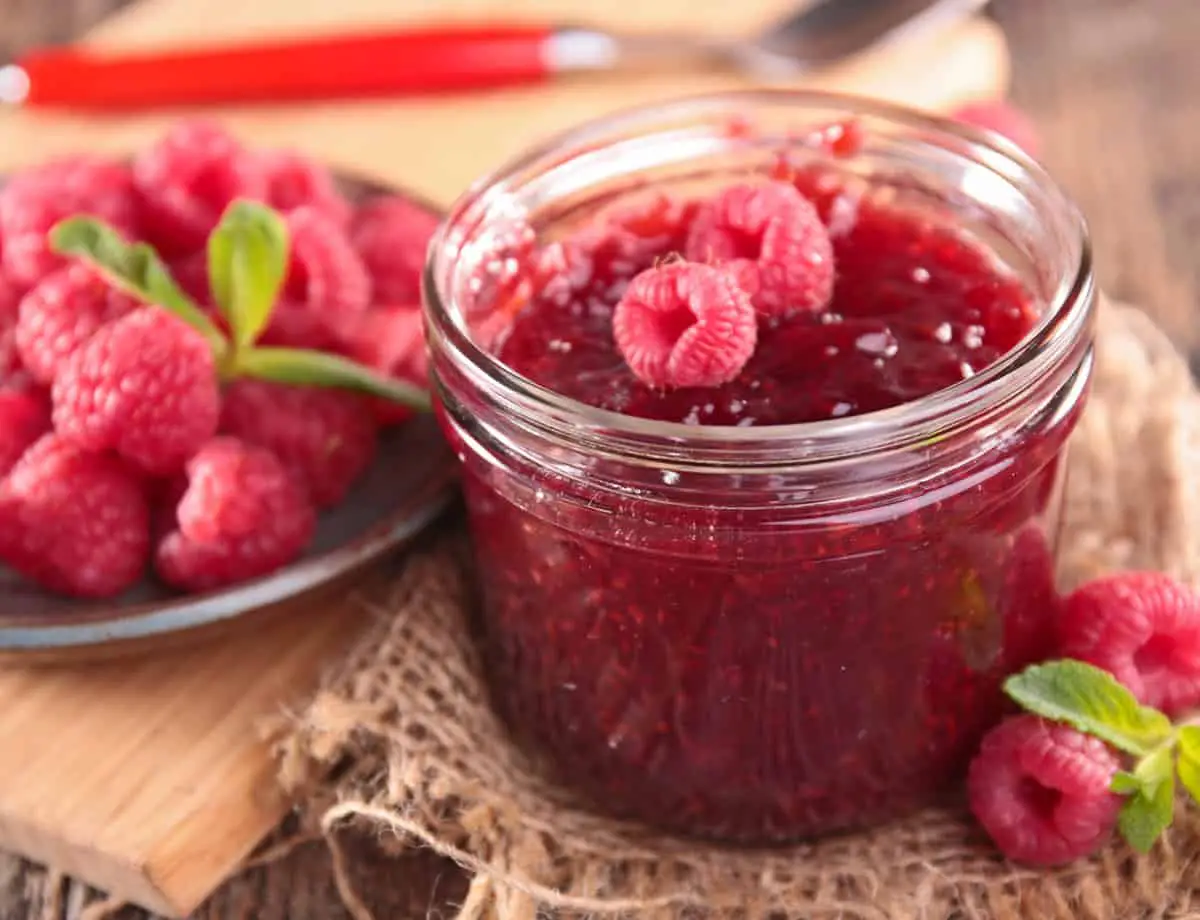Freezing Raspberries (A Quick & Easy Guide)
Raspberry season lasts from early June to the end of September, providing many gardeners and markets with a bounty of fresh berries.
Thankfully, not one raspberry needs to go to waste, you can enjoy this versatile berry all year long.
If you are wondering if raspberries can be frozen, the answer is yes. Raspberries freeze beautifully and are great in frosty drinks, pureed into a sauce, or as an addition to baked goods.
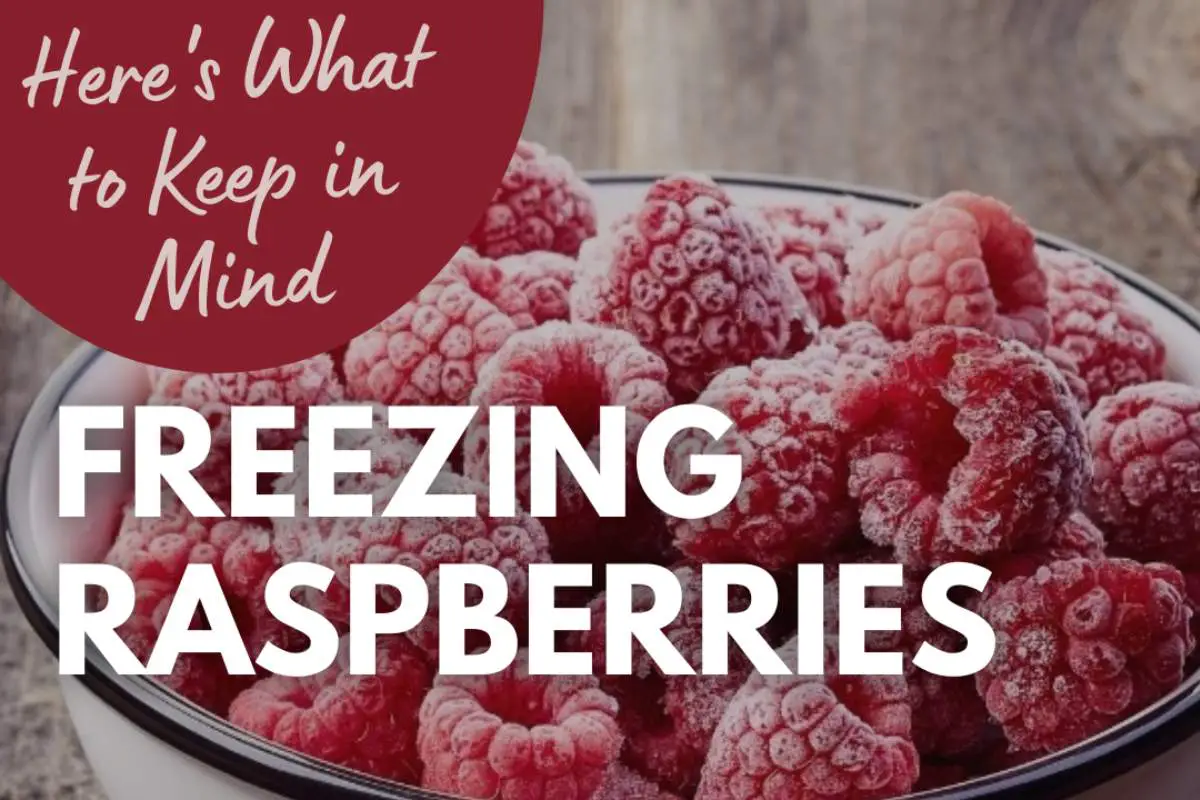
Continue reading to learn about freezing raspberries without compromising taste, nutrients, or flavor. You will also learn how to use frozen raspberries in some simple recipes.
How To Freeze Raspberries
Here is how to freeze raspberries properly, so that they can last for months in your freezer.
1. Choose Fresh Raspberries To Freeze
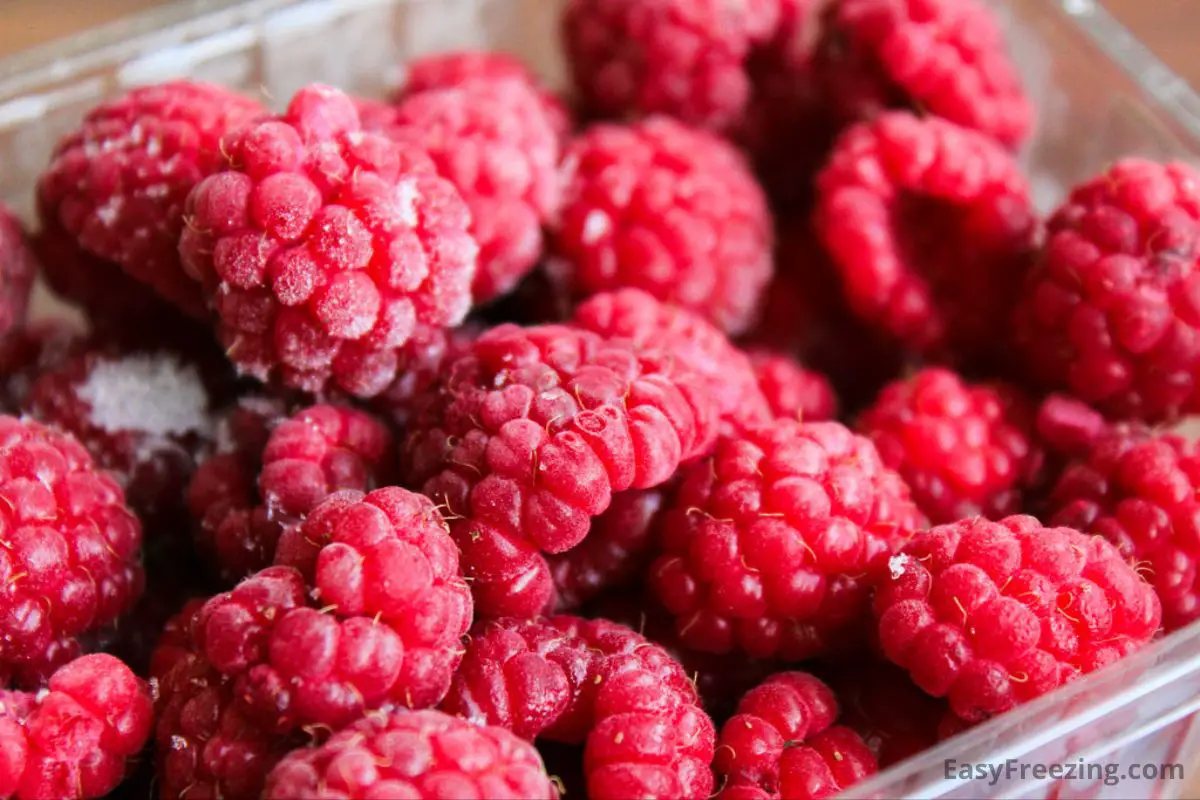
Your goal as a home cook is to have your frozen fresh berries taste as great as they did before you froze them.
To accomplish this you must freeze the freshest individual raspberries you can find.
The first crop of raspberries that are harvested each year are called summer-fruiting berries. They appear in your garden or at the market in June and July. This type of raspberry only bears one crop per season.
Everbearing raspberries begin producing crops of fruit continuously from June to September.
The best berries to freeze are firm, with no mold or darkness on the fruit. Be careful here. Just one bad raspberry can spoil an entire bag as freezing doesn’t keep mold or bacteria from spreading. It just slows it down.
Once the good fresh raspberries are separated from the bad, you can prep them for the freezer.
2. Rinse The Raspberries
A great thing about freezing raspberries is that there is no need to blanch them briefly in hot water first, as is the usual ritual with most produce.
However, you must thoroughly wash them, removing any leaves or other debris from the berry’s hollow.
Place fresh raspberries in a colander, then rinse them well under very cold water. Avoid crushing the delicate hull when you wash raspberries or they will get mushy.
3. Dry The Raspberries
Shake off any excess water and then lay them out on the kitchen counter. Pat the berries completely dry with a paper towel.
You want the raspberries to be completely dry before you move to the next step, otherwise, ice crystals will form on the fruit as they freeze, which compromises the berry.
4. Freeze Raspberries On A Tray
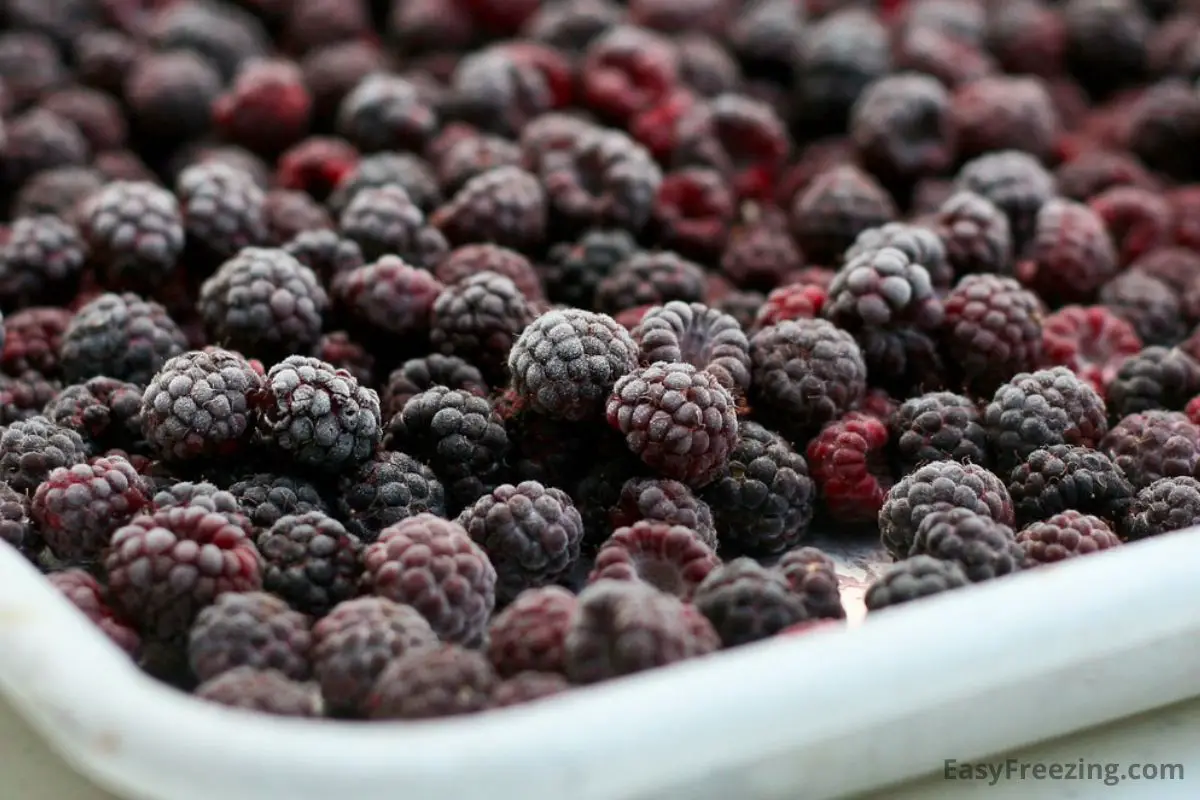
The best type of tray to use to freeze raspberries is a metal cookie sheet as metal transfers deep cold to the berries, allowing them to be flash frozen.
Before you place the berries, cover the cookie sheet with parchment paper to prevent the frozen berries from sticking to the tray.
Place the berries to be frozen close to each other in a single layer. Try not to allow them to touch, or they will stick together as they freeze.
When placing the tray in the freezer, make sure it is in the coldest part of your freezer space. The tray should also be level to prevent the raspberries from sliding together and clumping.
5. Remove Frozen Berries
Wait until the raspberries are frozen solid before you remove the cookie sheet from the freezer. Usually, this takes about one hour.
6. Pack Frozen Raspberries in Freezer Bags
Pack your raspberries in a thick plastic freezer bag with an air-tight zipper. You can use other freezer containers but they don’t eliminate as much air as freezer plastic bags.
Don’t use a thin sandwich bag, plastic bread bag, or anything else, as they are too porous to prevent air from entering the package. This causes freezer burn.
Label bags so that you remember the date of freezing, and when you’re ready to eat them use the oldest frozen batch first so that none of your frozen raspberries go past their best by date.
Frozen raspberries can last 18 months in the freezer if you removed all the air from the freezer bag when you froze them. Fresh raspberries stored in the fridge have a shelf life of only three days (or even a short few hours), so freezing raspberries will greatly extend their shelf-life.
Note: You can freeze blackberries and blueberries exactly the same way with great results.
How To Thaw Frozen Raspberries

There are several ways to thaw raspberries. These are all good methods, with some taking less time than others.
Thawing Raspberries on The Counter
Start by removing raspberries from the freezer. If you have frozen the raspberries correctly, they won’t be stuck together in the bag.
Place the raspberries in a bowl and cover them with cold tap water.
Set the bowl of berries on your kitchen countertop. If they haven’t thawed in ten minutes then dump the water from the bowl and replace it with new cold tap water.
When thawed, dump out the water and set the drained raspberries on a paper towel. Pat the berries dry and then use them however you would like.
Thawing Raspberries in The Fridge
Thawing berries in the fridge is safe and easy. However, it does take longer than other methods to thaw completely.
Simply take the freezer bag full of frozen fruit out of the freezer, place it in the refrigerator, and wait until thawed.
You can also remove the frozen fresh raspberries from the plastic bag and place them in the fridge in an airtight sealed container for about six hours (or overnight.)
Thaw Raspberries Rapidly In The Microwave
To rapidly thaw raspberries, place the desired amount in a microwave-safe bowl and set it to “defrost.”
Thaw the raspberries for 30 seconds. If not thawed, then keep using the defrost setting at ten-second intervals until done.
Tip: To make a raspberry syrup for a sundae or pancakes, add a tablespoon of sugar to the bowl and microwave on medium for 3-4 minutes.
Should Frozen Raspberries Always Be Thawed?
Frozen raspberries do not always have to be thawed, especially if you are making something like a smoothie.
Also, if you plan to use frozen berries in a cooked dish such as raspberry crisp, pancakes, or muffins, then no thawing is required. Just pop the frozen berries into the batter as they will thaw during the cooking process.
Alternatively, you can just choose to eat them frozen. In fact, eating frozen raspberries straight from the freezer is my favorite way to enjoy them!
Frozen Raspberry Recipes
The following recipes don’t require thawing the raspberries first.
Raspberry Freezer Jam
Making homemade raspberry freezer jam is quick and easy.
Combine a cup of frozen raspberries, a cup of sugar, half a cup of chia seeds, and water in a saucepan. Add a tablespoon of lemon juice.
Cook the frozen fresh berry and sugar mixture on medium heat, stirring with a spatula until the raspberries are broken down.
Pour the mixture into airtight glass jars or freezer containers until they are filled to the brim and store them in the freezer. Fresh raspberry freezer jam lasts for three months.
Raspberry Smoothie
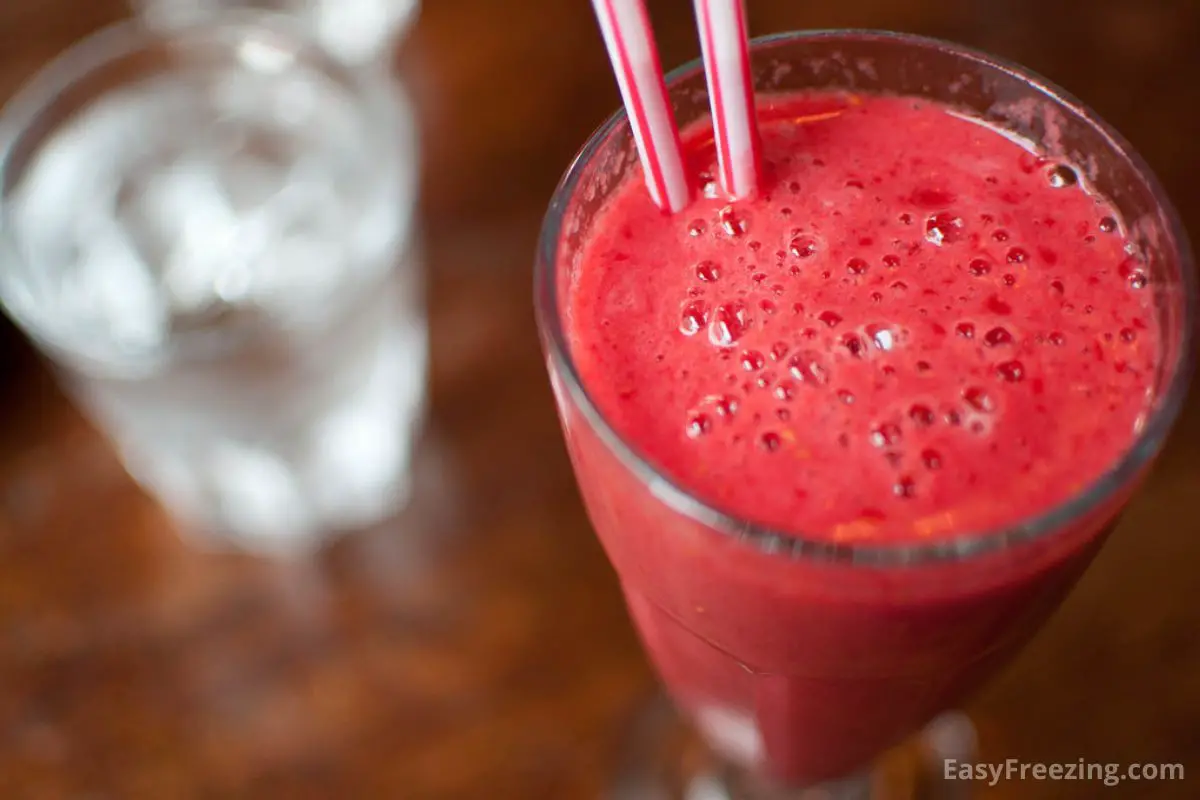
Blend ice, almond milk, frozen raspberries, and frozen bananas in a food processor or blender until smooth and frosty. Serve.
Raspberry Ice Cream
Add one cup of ice, a can of sweetened condensed milk, a dash of vanilla, and a cup of raspberries to a blender.
Blend until the mixture has the consistency of ice cream, and serve.
These are just a few recipes created with frozen raspberries to enjoy year-round. Still, one of the simplest and best ways to eat this fresh fruit is with vanilla yogurt.
Freezing Raspberries – Conclusion
So as you’ve seen, not only can you easily freeze raspberries, they last a very long time in the freezer (up to 18 months), and they can be used in many different ways all year long.
I hope this has inspired you to get out there during raspberry season and grab some berries to bring home and freeze.






